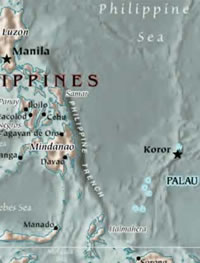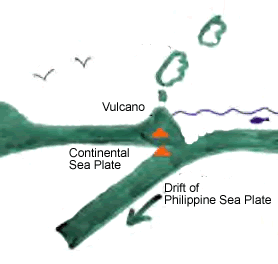|
The Philippine Trench
Until 1970 the Philippine Trench was regarded as the deepest point of the earth. In the meantime deeper trenches have been discovered. Deeper is the Mariana Trench (11,034 meters), the Tonga Trench (10,882 meters) and the Kuril Trench (10,542 meters).
The
Philippines Trench is result of a collision of earth plates. The
oceanic, only approx. five Measurements of the German ship "Emden" in 1927 delivered first indications of the depth of the Philippines Trench. The US- ship "Cape Johnson" measured in 1945 by echo-sounder a depth of 10,497 meters. In 1951 the Danish research ship "Galathea" found a maximal depth of 10,540 meters. Already in 500 meters depth there is absolute darkness. Since the hydrostatic pressure increases all ten meters about approximately one atmosphere, the Galathea-Deep has a pressure of approximately 1050 atmospheres. And in spite of that pressure there is still biological life in this depth. The research ship Galathea fetched from the "Cape Johnson Depth" onto surface carrion eating crabs, sea anemones, worms and living bacteria. However at this time ( July 2003 ) there exists no diving-robot, which can reach a depth up to eleven kilometres after the extremely depth-apt Japanese submersible Kaiko got lost during a tempest. In the Philippine Trench in a depth of until up to three miles one of the world-largest deposits of deuterium (heavier hydrogen) was also found. The isotope of the hydrogen can be used as non-polluting source of energy like fuel. And already bright future scenarios are developed in the Philippine press: "Wouldn't it be wonderful if, after all the gloomy forecasts, this untapped source of energy were to make the Philippines one of the richest countries of the world? The Philippine Trench lays according to the International Sea Law within the 200-miles Economic Exclusive Zone (EEZ) of the Philippines, so the deuterium could produced exclusively. But the production still has a lot of technical and financial difficulties in foreseeable time. More concrete and dangerous are other negative effects of the drift of sea plates - volcano eruptions and earth- and seaquakes. We mentioned already that the rock of the oceanic plate is melted during the plunge. Under the heat of the earth mantle it climbs through cracks of the continental crust and causes volcanoes. And when the two plates scratch and tangle each another the tensions are resolved in earthquakes. If the epicentre is under a seabed seaquakes (Tsunamis) are the result. Let us still mention a lukewarm joke that circulates on the Philippines and which refers to the Philippine Trench and the strong religiousness of the Filipinos. An airplane of the PAL is on the flight to the Philippines. Suddenly the captain reports: Ladies and Gentlemen, Mabuhay! This is your Captain Biglang-awa speaking, We are now over the Philippine trench where you can find the deepest part of the Pacific ocean. Here you can also find almost all the ferocious creatures in the sea, there's the killer sharks, barracudas and many others. And now for the finale, please, stay calm and don't panic for both our engines are dead and we are now going down into that ocean. Please wear your life vest. We are going to crash-land this plane into the water. In the meantime, I would like you to follow everything I'm going to say, repeat after me: "Our Father Who is in Heaven ......... © Wolfgang Bethge, 2004 |
 The
Philippines Trench (also: "Philippine Deep", "Mindanao Trench",
"Mindanao Deep) stretches with a length of approximately 1,320 km and a
width of round about 30 km from the northeast top of Luzon up to the
Indonesian Island of Malacca Halmahera. 10,540 meters depth were
measured in its deepest point - the Galathea Depth -. The Everest Mount
with his 8,846 meters of height would vanish smoothly in the deep sea
trench. For comparison - the Pacific Ocean reaches otherwise only an
average-depth of round about 4,190 meters.
The
Philippines Trench (also: "Philippine Deep", "Mindanao Trench",
"Mindanao Deep) stretches with a length of approximately 1,320 km and a
width of round about 30 km from the northeast top of Luzon up to the
Indonesian Island of Malacca Halmahera. 10,540 meters depth were
measured in its deepest point - the Galathea Depth -. The Everest Mount
with his 8,846 meters of height would vanish smoothly in the deep sea
trench. For comparison - the Pacific Ocean reaches otherwise only an
average-depth of round about 4,190 meters.  kilometres mighty, but specific heavier (basalt) Philippine Sea Plate
shifts itself with a rate from about 16 cm per year under the 60 km
mighty, specific lighter (granite) Eurasian Plate and gets melted by the
hot mantle of earth in a depth from 50 to 100 km. This geophysical
process is called subduction. In the subduction zone we
find the Philippines Trench.
kilometres mighty, but specific heavier (basalt) Philippine Sea Plate
shifts itself with a rate from about 16 cm per year under the 60 km
mighty, specific lighter (granite) Eurasian Plate and gets melted by the
hot mantle of earth in a depth from 50 to 100 km. This geophysical
process is called subduction. In the subduction zone we
find the Philippines Trench.